125 Physics Projects for the Evil Genius (46 page)
Read 125 Physics Projects for the Evil Genius Online
Authors: Jerry Silver

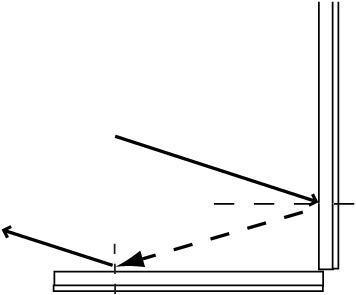
Figure 78-2
Mirrors at a right angle
.
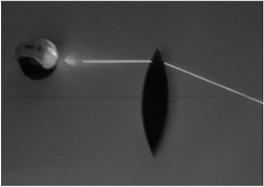
Figure 78-3
Convex lens
.
A
concave lens
is the one that is thinner at the middle than at the ends. Draw a centerline perpendicular to the axis of the lens. Trace the following paths: a) straight line along the center line through the center of the lens, b) a line above the centerline running parallel to the centerline, c) a line running below the centerline running and running parallel to it. Trace all the lines. How do these results compare with those from the convex lens?
The
semicircular lens
has one circular side and one flat side. Place the circular side toward you. Trace the lens and draw a centerline on the flat side. Shine the laser at a 30-degree angle to that centerline, but hit the point where the centerline meets the flat side of the lens. This particular arrangement avoids refraction in the glass because the light comes in perpendicular to the tangent at the circular edge. In this case, the only refraction that occurs is at the glass-to-air interface. Observe what happens for different angles. Take it to the extremes of high and low angles of incidence.
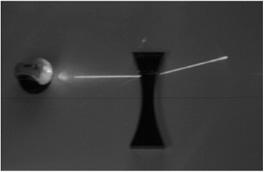
Figure 78-4
Concave lens
.
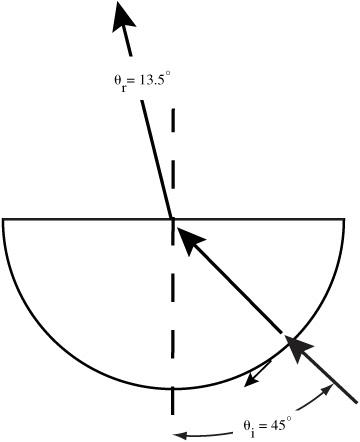
Figure 78-5
Semicircular lens
.
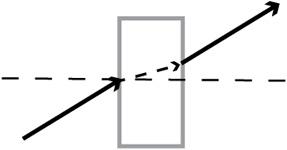
Figure 78-6
Rectangular prism
.
Draw a perpendicular line to one of the edges of the prism. (Make sure the edges you are using are clear and not frosted.) Direct the beam toward the point where the perpendicular meets the edge and trace the path of the laser through the prism at various angles.
There are two main types of right-angle prisms: 90°, 45°, 45° and 90°, 30°, 60°.
Here is a challenge. Try it either by working out the light rays first or by just playing with the prisms and figuring it out by trial and error:
a) How can you direct a light ray through the prism and have a ray emerge at 90 degrees to the incoming ray (based only on total internal reflection)?
b) How can you direct a light ray through the prism and have a ray emerge at 180 degrees to the incoming ray heading back in the direction that it came from (also based only on total internal reflection)?
The measurements should validate the idea that the angle of incidence equals the angle of reflection.
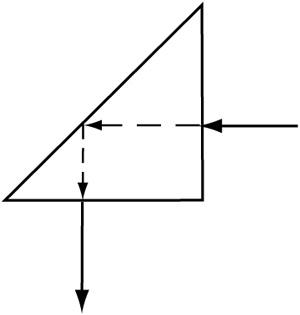
Figure 78-7
45-degree prism
.
Regardless of the angle at which the laser ray strikes the mirror, the ray reflected from the second mirror will be parallel to the incoming ray, but heading in the opposite direction.
Rays striking the lens traveling along the centerline will go straight through the lens without being diverted. Rays traveling parallel to the centerline bend toward the centerline and cross at a point (called the focal point) on the opposite side of the lens.
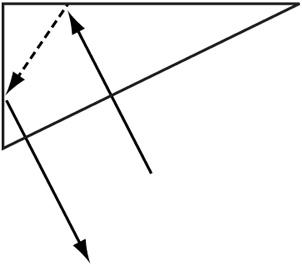
Figure 78-8
60–30 right-angle prism
.
Rays passing through a focal point on the same side of the lens as the laser (same distance as the focal point measured previously) emerge from the lens parallel to the centerline.
No matter where the rays hit the lens, the rays do not cross. Above the centerline, the rays bend up. Below the centerline, the rays bend down.
Rays hitting the semicircular side and directed toward the center of the circle bend (or refract) only when emerging from the glass to the air.
Rays emerging from the lens are parallel to the incident ray, but offset in the direction that rays move through the lens. As with all these observations, the path the ray takes in the prism is a
straight line
.
Rays striking one of the two shorter edges of the (90°, 45°, 45°) prism make a 90-degree turn, and then reflect back.
Rays striking the longer (hypotenuse) edge of the (90°, 30°, 60°) prism make a 180-degree turn, and then reflect back.
These produce a range of transmitted angles and conditions for total internal reflection.
Lenses
are optical devices that refract light passing from one medium (air) through another (glass or plastic), and then typically back to the air. At each interface, the light is bent according to Snell’s law.
Mirrors, whether involving one or many surfaces, reflect light in such a way that the angle of incidence equals the angle of refraction.
The lenses and mirrors previously described can also be studied using the following additional methods:
- Ray tracing with split beam. You can make or buy an apparatus that projects several parallel beams of light. Basically, the apparatus consists of a bulb covered by an enclosure that shines through parallel openings in the side of the enclosure. The beams of light, when directed at the various lenses and mirrors, show the properties of the devices in a graphic and intuitive way. This approach is better suited to smaller lenses and mirrors.
- Ray tracing by locating images. A more traditional approach is to view a vertical object such as a pin or a nail through the lens. This is accomplished by: a) tracing the outline of the lens, b) locating the position of the image seen through the lens, and c) drawing a line to show the incident, refracted, and transmitted paths of light.
Lenses and mirrors divert light in predicable ways. Lenses are based on refraction, while mirrors employ reflection. Some lenses are converging and direct rays of light passing through them through a focal point. Other lenses are diverging and direct the rays of light in such a way that they never cross. The reflection at the surface of any plane mirror occurs in such a way that the angle of incidence equals the angle of reflection.
Two candles, one flame
.
No, this is not the title of a bad country western song. This is a great optical illusion that is best shown to a group of observers who have
not
had the benefit of seeing how it was set up beforehand.
- 2 nearly identical candles
- match or lighter
- table
- pane of glass (or Plexiglas)
- way to hold the glass perpendicular to the table
safely and securely
. This works with someone simply holding the pane of glass on the table. A ring stand with a beaker clamp (or two) also works well.